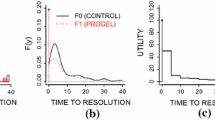Abstract
A strategy for MCMC estimation of a family of models involving multiple simultaneous dependence parameters is set forth that is capable of producing rapid estimates for problems involving a large number of observations. Simultaneous dependence parameters arise when dependence exists between dependent variable observations, with spatial and cross-sectional dependence being specific examples. The approach taken is to express the joint conditional distribution of the dependence parameters as a quadratic form, where the dependence parameters are outer vectors of the quadratic form and the inner matrix expressions of the quadratic form involve only sample data that allow these to be pre-calculated. During MCMC estimation, multiple evaluations of the joint conditional distribution of the dependence parameters can be carried out rapidly, allowing a block-sampling scheme. Block sampling of the dependence parameters is useful for imposing stability restrictions that arise for these parameters. In addition, a Taylor series approximation to the log-determinant expression that arises in the joint conditional distribution for the dependence parameters can be used to rapidly evaluate this term. The joint conditional distribution for the dependence parameters is obtained by analytically integrating out other model parameters, allowing Monte Carlo integration of the log-marginal likelihood, which can be used for model comparison. Timing results are discussed along with Monte Carlo evidence regarding performance as well as applied illustrations involving large sample sizes.




Similar content being viewed by others
Notes
We assume throughout that the dependent and independent variables (y, X) are continuous, and model disturbances (\(\varepsilon\)) are distributed normally with constant scalar variance \((\sigma ^2)\).
Multiple approaches to normalizing the matrix W have appeared in the spatial econometrics literature, all of which ensure that the maximum eigenvalue of the matrix W is one.
We use \(\tilde{M}\) to indicate that this matrix depends on estimates \(\hat{\rho }_1, \hat{\rho }_2, \hat{\rho }_3\).
Of course, this extension to the case of higher-order models does not require that \(\rho _1, \rho _2\) have the same sign. The reversible jump procedure in conjunction with a tuned random-walk procedure for proposing vectors \(\rho _1, \rho _2\) after some initial number of start-up draws was used.
It took 10 s to produce 40,000 MCMC draws for the 3107 US county dataset for which the times of 60,000 and 9900 s were reported in Han et al. (2018).
Problematical issues regarding interpretation of the partial derivatives from higher-order spatial autoregressive models as discussed by LeSage and Pace (2011). These problems do not plague the convex combination of weights model specification.
This is the approach taken by Han et al. (2018) in their application involving 3107 observations.
Han et al. (2018) do not discuss the issue of calculating effect estimates for their model.
For purposes of the figures, the log-marginal likelihood (logM) is converted to a scaled marginal likelihood using: \({\mathrm{exp}}({\mathrm{log}}M - {\mathrm{max}}({\mathrm{log}}M))\), leading to a maximum value of one in the figures.
References
Debarsy N, LeSage JP (2018) Flexible dependence modeling using convex combinations of different types of connectivity structures. Reg Sci Urban Econ 69:46–68
Debarsy N, Ertur C, LeSage JP (2012) Interpreting dynamic space-time panel data models. Stat Methodol 9(1–2):158–171
Dittrich D, Leenders R, Mulder J (2017) Bayesian estimation of the network autocorrelation model. Soc Netw 48:213–236. https://doi.org/10.1016/j.socnet.2016.09.002
Gelfand AE, Hills SE, Racine-Poon A, Smith AFM (1990) Illustration of Bayesian inference in normal data models using Gibbs sampling. J Am Stat Assoc 85(412):972–985
Han X, Hsieh C-S, Lee L-F (2018) Estimation and model selection of higher-order spatial autoregressive models: an efficient Bayesian approach. Reg Sci Urban Econ 63:97–120
Hepple LW (1995a) Bayesian techniques in spatial and network econometrics: 1. model comparison and posterior odds. Environ Plan A 27(3):447–469
Hepple LW (1995b) Bayesian techniques in spatial and network econometrics: 2. computational methods and algorithms. Environ Plan A 27(4):615–644
Lee LF, Yu J (2010a) Some recent developments in spatial panel data models. Reg Sci Urban Econ 40:255–271
Lee LF, Yu J (2010b) Estimation of spatial autoregressive panel data models with fixed effects. J Econom 154(2):165–185
LeSage JP (2014) Spatial econometric panel data model specification: a Bayesian approach. Spat Stat 9(C):122–145
LeSage J.P, Chih Y-Y, Vance C (2018) Spatial dynamic panel models for large samples, Paper presented at the North American Meetings of the Regional Science Association International, San Antonio, TX, November, 2018
LeSage J.P, Chih Y-Y (2019) Bayesian model comparison for space-time dynamic panel models, Paper presented at the SouthernRegional Science Association Meetings, Washington, DC, April, 2019
LeSage J.P, Fischer M.M (2018) The role of socio-cultural factors in static trade panel models, ResearchGate Working Paper, https://www.researchgate.net/publication/326201118_The_role_of_socio-cultural_factors_in_static_trade_panel_models. Accessed 13 Mar 2019
LeSage JP, Pace RK (2008) Spatial econometric modeling of origin-destination flows. J Reg Sci 48(5):941–967
LeSage JP, Pace RK (2009) Introduction to spatial econometrics. Chapman and Hall/CRC, Boca Raton, FL
LeSage JP, Pace RK (2011) Pitfalls in higher order model extensions of basic spatial regression methodology. Rev Reg Stud 41(1):13–26
LeSage JP, Thomas-Agnan C (2015) Interpreting spatial autoregressive interaction models. J Reg Sci 55(2):188–208
Mundlak Y (1978) On the pooling of time series and cross-section data. Econometrica 46:69–85
Pace RK, LeSage JP (2002) Semiparametric maximum likelihood estimates of spatial dependence. Geogr Anal 34(1):76–90
Parent O, LeSage JP (2011) A space-time filter for panel data models containing random effects. Comput Stat Data Anal 55(1):475–490
Parent O, LeSage JP (2012) Spatial dynamic panel data models with random effects. Reg Sci Urban Econ 42(4):727–738
Zellner A (1971) Introduction to Bayesian inference in econometrics. Wiley, New York
Author information
Authors and Affiliations
Corresponding author
Additional information
Publisher's Note
Springer Nature remains neutral with regard to jurisdictional claims in published maps and institutional affiliations.
Rights and permissions
About this article
Cite this article
LeSage, J.P. Fast MCMC estimation of multiple W-matrix spatial regression models and Metropolis–Hastings Monte Carlo log-marginal likelihoods. J Geogr Syst 22, 47–75 (2020). https://doi.org/10.1007/s10109-019-00294-2
Received:
Accepted:
Published:
Issue Date:
DOI: https://doi.org/10.1007/s10109-019-00294-2
Keywords
- Dynamic space–time panel data models
- Convex combination of weight matrix models
- Spatial origin–destination gravity models




